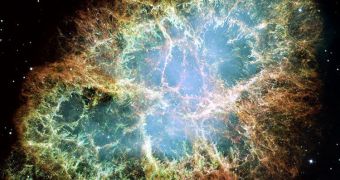According to the conclusions of a new scientific study, it would appear that it's not the pulsar at the core of the Crab Nebula that makes the object release so much radiation. Rather, the paper suggests that a very strong stellar wind may be responsible for causing the emissions.
Astronomers wondered about the behavior of the Crab Nebula ever since they first observed it in high-energy gamma-ray wavelengths. A huge powerhouse generating radiations was discovered right at its core, and experts were wondering about the processes that made such a phenomenon possible.
The Crab pulsar is what remains of a former massive star that went supernova long ago. Since the object's original mass was not sufficiently large, the star did not collapse into a black hole, but rather became a special type of neutron star.
However, scientists were fully aware that there was no way the fast-moving object was the source of all those intense radiations. The presence of a fast-moving wind within the nebula itself would provide a series of explanations for some of the weirdest readings experts get from this object.
“This puzzle – these unexpected, very high-energy gamma-ray emissions – come not from the pulsar, but from the wind. We are convinced that this is the most natural way to explain this path of emission,” Dublin Institute for Advanced Studies expert and lead study author, Felix Aharonian, explains.
What is also worthy of mention here is the fact that the Crab Nebula is one of the most well scrutinized objects in the night sky. It is located just 6,500 light-years away, and features a pulsar – two traits well worth studying. The object can be found in the constellation Taurus.
Details of its radiation emissions can be found in the February 15 online issue of the top scientific journal Nature. According to background data, Chinese and Native American early astronomers saw the progenitor star for this pulsar explode in 1054.
The Crab pulsar is still heavier than the Sun, even though it is only a few tens of miles across. It is spinning around its own axis around 30 times per second, which is not that fast for a star of its class.
“All energy from the pulsar goes to the wind, and the wind goes to the nebula and carries the energy, so the wind is kind of the bridge between the nebula and the pulsar,” Aharonian goes on to say, as quoted by Space.
“We've never seen the wind, but we postulate its existence because we cannot experience anything in the Crab nebula without that wind. It came from a theory, but we fully believe that – because we don't have other ideas of how these energies can be transferred from the pulsar to the nebula,” he concludes.

 14 DAY TRIAL //
14 DAY TRIAL //